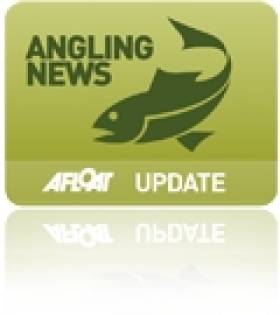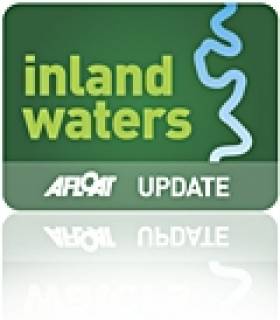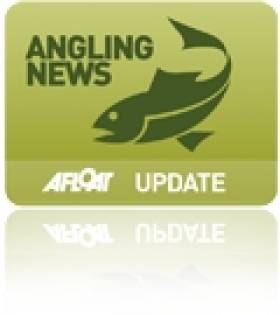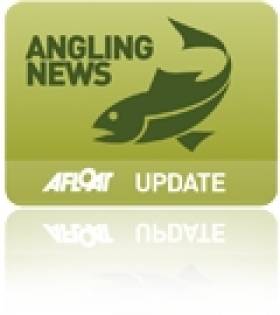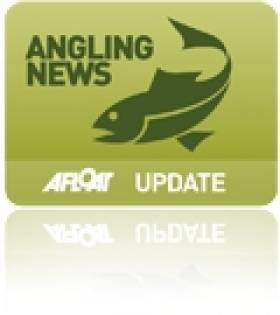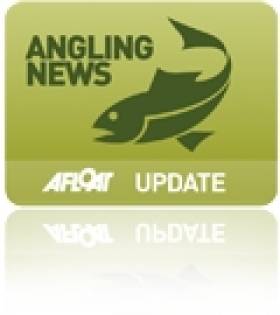Displaying items by tag: angling
Minister Opens White River Fishery Enhancement Project
#ANGLING - Minister of State Fergus O'Dowd was on hand at the opening of the White River enhancement project in Dunleer, Co Louth earlier this month.
The €32,000 project was funded by the Louth Leader Partnership, with works were carried out by the Dee and Glyde Fishing Development Association and the Dundalk district staff of Inland Fisheries Ireland.
The White River, a tributary of the River Dee, is considered hugely important as a spawning and nursery area, and it has already seen significant improvements in the levels of juvenile salmon and trout.
Instream enhancement works began in 2006, supervised by Inland Fisheries Ireland, and included the introduction of new gravel, weirs, deflectors and spawning beds which have helped the White River to achieve its potential in terms of fish numbers.
Speaking at the launch, Inland Fisheries Ireland CEO Dr Ciaran Byrne said: "The work that I have seen on the river is fantastic and a credit to all involved."
IFI assistant inspector in Dundalk, Ronan O’Brien, said project was based on restoring the natural features of the river.
He added that the programme was a great recognition of the work carried out by the Dee and Glyde Fishing Association, and that it had strengthened links with local business and development groups and could be used as a template for other projects in the area.
IFI Launches 2012 Sponsorship Programme
#ANGLING - Inland Fisheries Ireland (IFI) has announced the launch of its 2012 Sponsorship Programme.
The IFI Sponsorship Programme aims to increase awareness of IFI and its work, recreational angling, the sustainable commercial use of the inland fisheries resource and habitat issues.
Applications are invited from organisers and event promoters that will support the aims of the IFI sponsorship programme.
Events would be supported on the basis of: the location and nature of the event; the potential of the event to introduce new users to angling in an active capacity (ie not just as spectators); and to educate and inform stakeholders of angling, environmental, commercial salmon fisheries and habitat issues.
"The sustainable use of our wonderful inland fisheries and sea angling resources must be promoted," said Minister for Communications, Energy and Natural Resources, Pat Rabbitte, who launched the programme.
"People of all ages can enjoy angling in urban and rural settings, off charter boats and beaches and on quiet riversides.
"In addition, traditional commercial fisheries add value to small local communities, while biodiversity awareness ensures a sustainable resource for all."
Applications and details of the sponsorship programme are available online or from your local IFI office. The closing date for submissions is 27 January 2012.
First Phase of Thomastown River Project Complete
#INLAND WATERWAYS - The first phase of a project to restore the Thomastown river was launched at the weekend with the opening of a new weir, the Kilkenny People reports.
Fundraising efforts by the Thomastown Community River Trust have already led to the regeneration of the riverbank from the town up to Thomastown Viaduct.
The new causeway also forms part of a planned trail from Bennettsbridge to Inistioge.
The trust's project was "focused on using environmentally friendly and sustainable engineering", working in partnership "with a diverse range of groups from walkers to kayakers and anglers".
Work is already underway on the second phase that aims to see the restoration of the weir, which collapsed in 2008, as well as the sluice and mill wheel, in an effort to re-establish the swimming pond and fish pass.
The Kilkenny People has more on the story HERE.
Carlow CAC Receives Bursary for Disabled Angling Efforts
#ANGLING - Carlow Coarse Angling Club chair Gerry McStraw was presented last week with a special bursary by Carlow Sports Partnership for the club's efforts in helping disabled anglers to participate in the sport.
According to the Enniscorthy Guardian, McStraw was joined by Carlow CAC PR officer Ian Warburton and treasurer George Quinlan in receiving the money from Carlow Sports Partnership chair Tracey Byrne and Carlow County Council's Thomas Kinsella.
McStraw was recently highlighted on Afloat.ie for his spearheading of the revival of coarse fishing in Ireland.
The bursary will be used to buy equipment essential to running more coarse angling programmes in 2012.
Carlow CAC will also host three of the six weekends for the National Coarse Fishing Federation of Ireland's qualifiers next spring and summer.
#ANGLING - The 30-day public consultation on new regulations for the management of the 2012 wild salmon and sea trout fishery will expire next Thursday, The Irish Times reports.
The new regulations are based on advice from Inland Fisheries Ireland following an assessment of 141 rivers nationwide by the Salmon Standing Scientific Committee.
That assessment recommended that that 43 rivers should open (seven fewer than in 2011); 34 rivers should open for catch-and-release (six more than 2011); and 64 rivers should be closed (one fewer than 2011).
New conservation rules include bag limit for sea trout and a restriction on angling for other species when fishing for salmon on closed rivers.
The Irish Times has more on the story HERE.
Dates Announced for Coarse Fishing Qualifiers in 2012
#ANGLING - Qualifiers to select teams for the 2013 World, European and Celtic Cup coarse fishing teams will be fished over six weekends in 2012.
The float and feeder teams for the National Coarse Fishing Federation of Ireland (NCFFI) squads will be decided via an All Ireland Qualifier format to CIPS rules.
Team manager Mark Theedom will select his teams from the top 20 anglers in the float qualifiers and the top 50% of anglers taking part in the feeder qualifiers.
The series will be open to all anglers who are members of NCFFI-affiliated clubs, and is intended to be more inclusive and encourage many more anglers to participate.
All senior anglers will pay an entry fee of €60 for the six-match series which will help fund teams travelling to the 2013 championships. Individual anglers not intending to fish the series but wishing to fish individual qualifiers in their local area will be charged €15. Juniors will not be expected to pay any entry fee.
The qualifier weekends are as follows:
- 21-22 April – River Barrow, Co Carlow
- 19-20 May – Inniscarra, Co Cork
- 2-3 June – River Shannon (O’Brien’s Bridge), Co Clare
- 11-12 August – Lough Muckno, Co Monaghan
- 22-23 September - Lough Oughter, Co Cavan
- 20-21 October – Lower River Bann, Co Antrim
Carlow Angler Spearheads Coarse Fishing Revival
#ANGLING - Tuesday's Enniscorthy Guardian writes about the revival of coarse fishing in Ireland, spearheaded by Gerry McStraw, chairman of Carlow Coarse Angling Club.
McStraw runs a tackle and bait business in Graiguecullen on the River Barrow, which has made a comeback after years of heavy poaching, and become a safe environment for families to enjoy.
Bream, hybrids, roach, dace and perch are now in abundance in the river - with bag weights of up to 50 lb of roach possible - while the pike pose a worthy challenge for the determined angler.
Carlow Sports Partnership will award a special bursary to the club on Wednesday 30 November in recognition of its work not only in protecting the river but also in youth development.
The Enniscorthy Guardian has more on the story HERE.
Life Choked Out of North Dublin Fishing Pond
#ANGLING - The public fishing pond at Darndale is "crying out for help" after an infestation of curly weed, The Irish Times reports.
A public meeting to discuss the issue recently heard that the invasive plant has spread throughout the entire pond, making casting all but impossible.
“We have a catchment of some 3,000 youngsters and adults who are deprived of fishing in their locality," said Brian Conneely of Sphere 17 Youth Service. "It’s a sad state of affairs.”
The meeting also heard of a possible solution to the problem, with Dr Joe Caffrey of Inland Fisheries Ireland suggesting a covering of jute or sacking to kill off the weed and allow the growth of native plants - a plan that appears to be working in Lough Corrib.
Costing is the issue, however, with such a jute priced at around €5,000. Maryann Harris of Dublin City Council's parks division said she was exploring grants to fund the project.
The Irish Times has more on the story HERE.
Tribute to River Liffey Salmon Pioneer
#ANGLING - A plaque paying tribute to the late secretary of the Dublin Salmon Anglers' Association has been inveiled at Carton Estate in Co Kildare.
Patrick 'Pat' O'Molloy, who died in November last year, was commemmorated for his pioneering work over the last 35 years in the rehabilitation and restoration of wild salmon stock in the River Liffey, The Irish Times reports.
This involved introducing micro-tagged smolts into the Rye, a tributary of the Liffey upriver of the Carton Estate weir which was impassable from further downstream.
Sadly O'Molloy died before the return of salmon to the Liffey in a year that also saw their return to the Tolka afer more than a century.
Former fisheries CEO Alan McGurdy said at the ceremony: "As you all know, Pat was an angler, a board member, environmentalist, fish farmer and most of all, a friend.
"Today is some recognition to the great man for the tremendous work he did to look after our fish."
Fishing in Blue Stacks Highlighted in New Film
#ANGLING - A new film on fishing in south Donegal will have its premiere this Thursday, the Donegal Democrat reports.
The film, The Blue Stack Mountains, is the fourth in a series on angling in Ireland by German producer Dietrich Bohnhorst, whose previous angling documentaries have been broadcast on television around the world.
According to Bohnhorst, who has lived in Donegal for 25 years, his latest film “describes a journey from Glenties, through Commeen, Stranorlar, Ballybofey and back over Barnesmore Gap to Donegal town."
It also pays special attention to “about 40 lakes which lie in the Blue Stacks, how to get there and where to fish, what flies to use and so on.”
Bohnhorst hopes his film will help to break the "invisible line" that he says has cut off the "under-promoted" Donegal from the marketing of angling in Ireland.
All are invited to the premiere at Solis Lough Eske Castle this Thursday at 8pm. Admission is free.



























